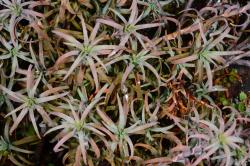- Taxon
- Gallery
- = Dracophyllum tenuicaulis Colenso, Trans. & Proc. New Zealand Inst. 22: 476 (1890)
- = Dracophyllum brachyphyllum Colenso, Trans. & Proc. New Zealand Inst. 28: 604 (1896)
- = Dracophyllum brachycladum Colenso, Trans. & Proc. New Zealand Inst. 31: 275 (1899)
Us. a low spreading shrub, sts attaining 1 m. tall and ± 1 m. diam.; branches wide-spreading, bark dark grey to blackish; branchlets slender, reddish brown. Lvs crowded towards tips of branchlets, spreading to strongly reflexed, us. dark coloured. Sheath membr., 2.5–4(6) mm. broad, ciliolate, abruptly narrowed to coriac., dark red-brown, linear-subulate lamina (green in shade) 2–4 cm. × 1–1·5 mm.; margins minutely serrulate, apex acute to subacute. Racemes terminal on branchlets, 4–10-fld, 12–25 mm. long with stout axis. Bracts persistent, almost concealing fls; lower lflike, tips subulate to lanceolate, c. 5 mm. long. Sepals ovate-lanceolate, acute, ciliolate, ± = corolla-tube. Corolla narrow-campanulate to cylindric; tube c. 6 mm. long, lobes c. 3 mm. long, sub-acute, ovate-triangular, red to white. Anthers included; style stout, c. 2 mm. long. Capsule 3–4 mm. diam., concealed by persistent sepals.
[From: Allan (1961) Flora of New Zealand. Volume 1.]




